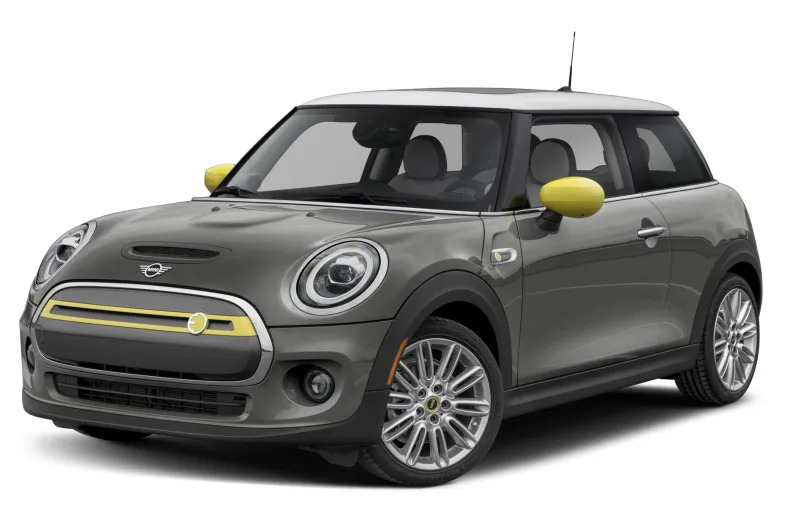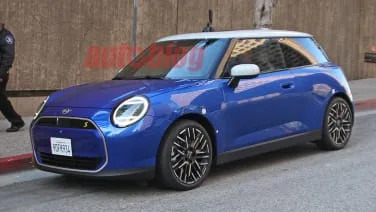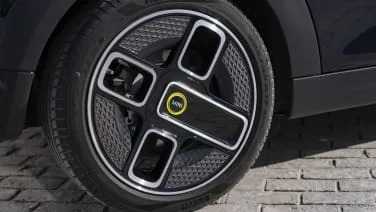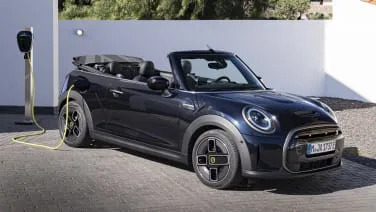2021 MINI SE Hardtop
The range meter of my fully charged 2020 Mini Cooper SE reads 110 miles as I fasten my seatbelt, which is hardly a surprise because that number matches the official EPA-certified range of this all-new electric car. But then I turn on the climate control system, at which point the range prediction promptly falls to 103 miles. “Uh-oh. This could get interesting,” I say to myself. My range test course, you see, is a vast loop that measures about 105 miles around. I don’t really think I’ll end up walking, though. I remind myself that most electric cars I’ve tested — the Porsche Taycan among them — routinely outperform their rated range. But “most” is the operative word in this train of thought, so I ease out of my driveway to begin the test under a tiny cloud of uncertainty. Will the Mini Cooper SE prove to be one of the outliers? Will I encounter any low battery warnings? All will become clear in the next three and half hours. None of my initial hand-wringing should be taken to mean the Mini’s rated range of 110 miles is somehow insufficient. It’s not, in my view. The length of my course has no special meaning. It doesn’t represent the “right” number of miles. How the test was run My loop in Orange County, Calif., represents what I call typical suburban city driving. It’s not as dense as the notorious gridlocked areas found in West Los Angeles or certain big-city downtown environs, so it’s applicable to the vast majority of drivers. It features suburban residential and arterial streets, with speed limits that range from 25 mph to as much as 60 mph. But there’s no pure freeway mileage, and the entire route is peppered with more than 310 signals. As for elevation, it ranges from sea level to just over 600 feet. I run with the automatic climate control system set within the range of 72 to 75 degrees, aiming to settle on one specific setting throughout that delivers adequate comfort. I’ll try whatever Eco drive mode there is, but if throttle response is anemic I’ll use the normal setting. Here, the default mode is the “green” mode, and I’m sticking with it because the SE’s driveability is totally agreeable. As for speed, I’m running mid-pack between the leadfoots and the slowpokes. I won’t try to out-drag anyone leaving signals, and I look far enough ahead that I can choose the best lane and anticipate when the next signal is going to change. In short, I’m aiming to land halfway between hypermiling and hyperactive. As a rule, I’ll use the one-pedal driving mode if the regenerative braking system supports it. The Mini SE has such a setting, and it’s the start-up default, too. Perfect. Looking good Things get off to a good start. The view out is expansive, and like any Mini Cooper the driving position is easy to customize for reach and rake. There’s plenty of headroom and legroom, more than …
Full Review
The range meter of my fully charged 2020 Mini Cooper SE reads 110 miles as I fasten my seatbelt, which is hardly a surprise because that number matches the official EPA-certified range of this all-new electric car. But then I turn on the climate control system, at which point the range prediction promptly falls to 103 miles. “Uh-oh. This could get interesting,” I say to myself. My range test course, you see, is a vast loop that measures about 105 miles around. I don’t really think I’ll end up walking, though. I remind myself that most electric cars I’ve tested — the Porsche Taycan among them — routinely outperform their rated range. But “most” is the operative word in this train of thought, so I ease out of my driveway to begin the test under a tiny cloud of uncertainty. Will the Mini Cooper SE prove to be one of the outliers? Will I encounter any low battery warnings? All will become clear in the next three and half hours. None of my initial hand-wringing should be taken to mean the Mini’s rated range of 110 miles is somehow insufficient. It’s not, in my view. The length of my course has no special meaning. It doesn’t represent the “right” number of miles. How the test was run My loop in Orange County, Calif., represents what I call typical suburban city driving. It’s not as dense as the notorious gridlocked areas found in West Los Angeles or certain big-city downtown environs, so it’s applicable to the vast majority of drivers. It features suburban residential and arterial streets, with speed limits that range from 25 mph to as much as 60 mph. But there’s no pure freeway mileage, and the entire route is peppered with more than 310 signals. As for elevation, it ranges from sea level to just over 600 feet. I run with the automatic climate control system set within the range of 72 to 75 degrees, aiming to settle on one specific setting throughout that delivers adequate comfort. I’ll try whatever Eco drive mode there is, but if throttle response is anemic I’ll use the normal setting. Here, the default mode is the “green” mode, and I’m sticking with it because the SE’s driveability is totally agreeable. As for speed, I’m running mid-pack between the leadfoots and the slowpokes. I won’t try to out-drag anyone leaving signals, and I look far enough ahead that I can choose the best lane and anticipate when the next signal is going to change. In short, I’m aiming to land halfway between hypermiling and hyperactive. As a rule, I’ll use the one-pedal driving mode if the regenerative braking system supports it. The Mini SE has such a setting, and it’s the start-up default, too. Perfect. Looking good Things get off to a good start. The view out is expansive, and like any Mini Cooper the driving position is easy to customize for reach and rake. There’s plenty of headroom and legroom, more than …
Hide Full Review
Hide Full Review
Retail Price
$29,900 - $29,900
MSRP / Window Sticker Price
| Engine | |
| MPG | Up to 115 city / 100 highway |
| Seating | 4 Passengers |
| Transmission | 1-spd auto |
| Power | 181 @ 7000 rpm |
| Drivetrain | front-wheel |
| Curb Weight | 3,153 lbs |
Smart Buy Program is powered by 





